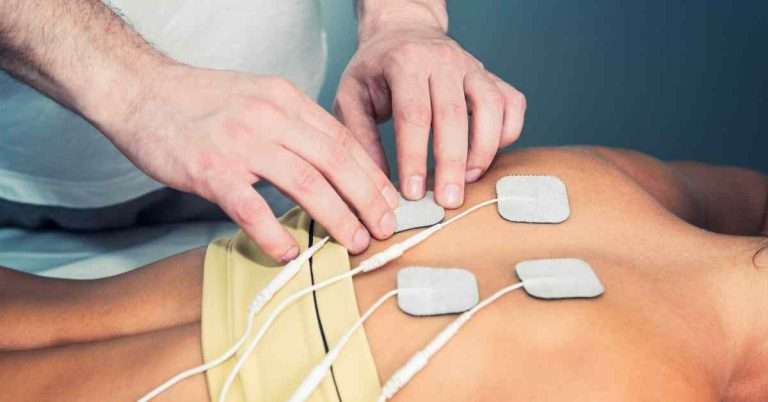Chronic is a debilitating condition affecting millions worldwide. Traditional treatments often involve medications, which can have side effects or become less effective over time. Enter Scrambler Therapy for pain, a cutting-edge, non-invasive treatment gaining traction as a promising solution for relief.
What is Scrambler Therapy?
Scrambler Therapy is a novel pain management approach that uses a machine to “scramble” pain signals before they reach the brain. Instead of the pain signals, the brain perceives a non-painful sensation, effectively “retraining” the brain to interpret pain differently.
How Does Scrambler Therapy Work?

Scrambler therapy involves placing electrodes on the skin near the pain site. These electrodes deliver low-level electrical signals that mimic the body’s nerve impulses. The “scrambled” signals confuse the brain, interpreting the pain sensation as a regular, non-painful signal. Over time and with repeated sessions, the brain starts recognizing these signals as the new norm, reducing or eliminating the pain sensation.
Scrambler Therapy in Modern Medicine
Johns Hopkins Medicine has highlighted the potential of Scrambler Therapy in providing lasting relief for chronic pain. Their review suggests that patients who underwent the therapy experienced significant pain reduction, with some even achieving complete pain relief.
The Foundation for Peripheral Neuropathy also acknowledges the potential benefits of Scrambler Therapy, especially for neuropathic pain. They emphasize its non-invasive nature and the absence of side effects as significant advantages over traditional treatments.
Benefits of Scrambler Therapy
- Non-Invasive: Unlike surgeries or injections, Scrambler Therapy is entirely non-invasive.
- Drug-Free: It offers a drug-free alternative, reducing the risk of medication side effects.
- Quick Sessions: Each session lasts about 30-45 minutes.
- Long-Lasting Relief: Many patients experience prolonged pain relief after completing their treatment sessions.
- Suitable for Various Pain Types: Scrambler Therapy has shown promise in treating various pain conditions, from chronic pain, neuropathic pain to post-surgical pain.
What’s the difference between scrambler therapy and a TENS unit?

Scrambler Therapy and TENS (Transcutaneous Electrical Nerve Stimulation) are both non-invasive treatments that use electrical signals to manage pain. However, they operate on different principles and are used for different purposes. Here’s a breakdown of their differences:
- Principle of Operation:
- Scrambler Therapy: This therapy “scrambles” pain signals before they reach the brain. It sends non-painful signals to the brain, effectively “retraining” it to interpret pain differently. The goal is to replace the pain signal with a non-painful signal.
- TENS Unit: TENS sends electrical pulses across the skin’s surface and along the nerve strands. These electrical pulses help to block pain signals from reaching the brain. Additionally, they help stimulate the production of endorphins, the body’s natural painkillers.
- Purpose:
- Scrambler Therapy: Primarily used for chronic pain conditions, especially neuropathic pain. It’s been used for postherpetic neuralgia, chemotherapy-induced peripheral neuropathy, and back pain.
- TENS Unit: Used for various pain types, including acute and chronic pain. It’s commonly used for musculoskeletal pain, such as back pain, arthritis, and other joint or muscle pains.
- Duration of Relief:
- Scrambler Therapy: Offers prolonged pain relief after completing a series of treatment sessions. Some patients report long-lasting relief.
- TENS Unit: Provides temporary pain relief. The relief can last a few hours after the treatment, but the device may need to be used multiple times daily for continued relief.
- Device Placement:
- Scrambler Therapy: Electrodes are placed on the skin near the pain site but not necessarily on the exact location of the pain.
- TENS Unit: Electrodes are typically placed directly on or around the area where the patient is experiencing pain.
- Safety and Side Effects:
- Scrambler Therapy: Generally considered safe with minimal side effects. Some patients might experience mild discomfort during sessions.
- TENS Unit: This is also considered safe, but some people might experience skin irritation from the adhesive pads. It’s not recommended for people with pacemakers or certain other medical conditions.
- Adoption in Medical Community:
- Scrambler Therapy: Relatively new, with growing interest and research in the medical community. Some major medical institutions have begun offering it as a treatment option.
- TENS Unit: Widely adopted and has been in use for decades. It’s a standard recommendation for various pain conditions.
In summary, while Scrambler Therapy and TENS units use electrical signals to manage pain, they have different mechanisms of action, purposes, and outcomes. Patients must consult with healthcare professionals to determine the most suitable treatment for their condition.
Top-Rated Scrambler Therapy Clinics
- Johns Hopkins Medicine: Known for its pioneering medical research, they offer Scrambler Therapy as part of their pain management solutions.
- Mayo Clinic: Another reputed institution that provides Scrambler Therapy for chronic pain sufferers.
- Calmare NJ: Specializing in Scrambler Therapy, they’ve treated numerous patients with varying pain conditions.
- Ask your doctor: Scrambler therapy is only available from a medical providers for now, so ask your care team where you can get it done.
Safety and Considerations
While Scrambler Therapy is generally considered safe, consulting with a healthcare professional before starting the treatment is essential. Some patients might experience mild discomfort during the sessions, usually temporary. Choosing a reputable clinic with experienced practitioners is also crucial to ensure the best results.
Conclusion
Scrambler Therapy offers a beacon of hope for those grappling with chronic pain. Its innovative approach, backed by modern medical institutions, suggests a future where pain management might not rely heavily on medications or invasive procedures. As with any treatment, it’s essential to be well-informed and consult with professionals, but the initial results are promising.
More Stories
Find more amazing stories on the blog!
References:
2. Scrambler Therapy for Treating Neuropathic Pain – Foundation for Peripheral Neuropathy




